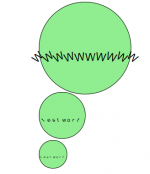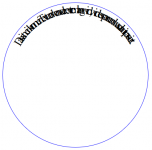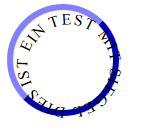<!DOCTYPE html>
<html>
<head>
<meta http-equiv="content-type" content="text/html; charset=UTF-8">
<title>Fenstertitel</title>
<style type="text/css">
#round {
position: relative;
display: inline-block;
white-space: nowrap;
border: 1px solid blue;
font-size: 2em;
text-align: center;
height: 0px;
width: 0px;
padding: 200px;
border-radius: 100%;
}
#round .char {
position: absolute;
display: inline-block;
transform-origin: 50% 0%;
border: 0px solid red;
}
</style>
</head>
<body>
<span id="round">Das ist mein krummer Text und wenn der extrem lang wird, wird es spannend was damit passiert.</span>
<script type="text/javascript">
(function(){
var round = document.getElementById("round");
var text = round.textContent;
round.innerHTML = "";
var radius = round.offsetWidth / 2;
var textNodes = text.replace(/\s/, " ").split("").map(function(char){
var charNode = document.createElement("span");
charNode.className = "char";
charNode.appendChild(document.createTextNode(char === " "? "\xA0" :char));
return charNode;
});
textNodes.forEach(function(node){
round.appendChild(node);
});
var textWidth = textNodes.reduce(function(width, node){
return width + node.offsetWidth;
}, 0);
var textHeight = textNodes.reduce(function(height, node){
return Math.max(height, node.offsetHeight);
}, 0);
var unit = "px";
var fontSize = textNodes.reduce(function(fontSize, node){
var font = window.getComputedStyle(node).fontSize;
unit = font.replace(/\d+/g, "");
return Math.max(fontSize, parseInt(font, 10));
}, 0);
while (fontSize > 0 && textWidth > 2 * Math.PI * (radius - textHeight)){
fontSize -= 0.1;
textNodes.forEach(function(node){
node.style.fontSize = fontSize + unit;
});
var textWidth = textNodes.reduce(function(width, node){
return width + node.offsetWidth;
}, 0);
var textHeight = textNodes.reduce(function(height, node){
return Math.max(height, node.offsetHeight);
}, 0);
}
var angleRange = textWidth / (radius - textHeight);
var xBend = 0;
textNodes.forEach(function(node){
xBend += node.offsetWidth / 2;
var angle = -(Math.PI + angleRange * (-1 + 2 * xBend / textWidth) / 2);
node.style.transform = "rotate(" + (180 - angle * 180 / Math.PI) + "deg)";
node.style.top = (radius * (1 + Math.cos(angle))) + "px";
node.style.left = (radius * (1 + Math.sin(angle)) - node.offsetWidth / 2) + "px";
xBend += node.offsetWidth / 2;
});
}());
</script>
</body>
</html>




